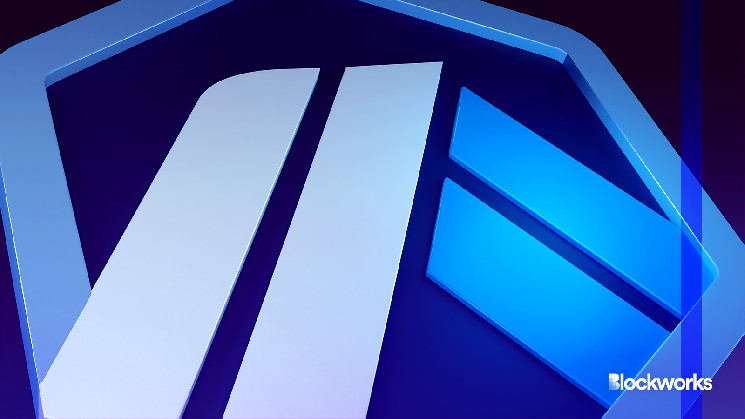The perpetual futures exchange landscape is undeniably crowded at this stage, with literally hundreds of offerings available.
Many offer similar user experiences and features, and only the top 20 or so have attracted a meaningful amount of trader capital or volume. Fewer still can compete with centralized exchanges in terms of order execution and liquidity.
Newcomer D8X, which is now available on Arbitrum, has several features that its founders hope will let it stand out from the crowd.
It’s a full-fledged on-chain perp DEX protocol using an automated market-making (AMM) approach with no centralized order book.
The protocol is designed to be a white label product, with an open-source front-end kit available to third party operators, similar to the model pioneered by Liquity, according to co-founder Caspar Sauter.
Read more: Liquity aims to build on safety record with V2 using staked ether
“We built a system from the ground up in a way that every component is as decentralized as possible,” Sauter told Blockworks.
The first such frontend was Octofi.io, with Freely Perps as a close second. Freely Perps is a frontend affiliated with Freely Finance, which also runs one for Liquity.
One of the biggest problems for all derivatives DEXs is bootstrapping a minimum viable amount of liquidity to make the trading experience pleasant. In D8X’s case, all frontends have the option to share liquidity via the protocol, making it easier for developers to get started without having to focus on infrastructure or bringing market makers to the platform.
This should appeal to spot DEXs, for instance, which can add perps easily within their existing brands. It’s also a solid option for smaller niche trading venues, like ones launched by KOL traders with their own brand.
“For them, it’s mainly interesting because if you’re either an alpha group or a KOL, you have a simple place to market and expand your brand where your users can still trade,” Sauter said.
D8X even includes a referral system out of the box. The protocol charges a white label partner fee of a few basis points.
Neither the frontends nor the protocol itself are subject to Swiss financial market laws, Sauter said.
Read more: Crypto needs to be a ‘hole’ lot more Swiss
“From a Swiss point of view, our Swiss law firm assessed what it would mean to host a frontend in Switzerland. And essentially, given [that] the whole exchange stack is completely decentralized, what you’re doing is providing a gateway to a decentralized exchange,” he said.
‘Ethena on-chain’
DeFi composability is front and center with the Arbitrum launch.
The new deployment uses Angle Protocol’s staked USDA (stUSD) as collateral for bitcoin trading, meaning traders earn a yield on deposited capital. Other derivatives DEXs like Aevo have offered this before but D8X’s is more generalized.
“The trade engine allows for ERC20-specific collateral pools which gives us — from a product perspective — quite some unique features,” Sauter explained.
The first example is the integration with EtherFi’s wrapped restaked ether (weETH) as collateral for the ETH/USD pair. This allows for what amounts to an “Ethena on-chain” strategy — shorting ether futures against weETH holdings to eliminate Ethena’s counterparty risk associated with its use of centralized futures exchanges.
The protocol also prices perps differently than, for instance, the popular Arbitrum perp DEX GMX, which applies a borrowing fee to both sides of a trade.
Sauter calls D8X’s funding model “classical perpetuals” in the sense that one side pays funding rate [and] the other side receives the funding rate depending on demand and supply,” thus making hedging cheaper.
The use of bespoke collateral can be extended to any ERC20, subject to custom risk parameters. For example, Arbitrum’s governance token ARB could be offered as a collateral option. D8X deployments on OKX’s X Layer already does this with its OKB token.
Read more: OKX turns on its L2 mainnet, joining the exchange chain club
Using volatile collateral may be risky, but Sauter says there’s demand to add utility to a variety of crypto assets.
“The volatility of the collateral doesn’t matter too much if you pay attention [to] the leverage that you’re accepting,” he said, noting that “there are large holders in the OKB ecosystem that are interested [in doing] stuff with their OKB.” He thinks that “from an LP perspective, it’s a no-brainer.”
Risk management is a key concern, he added, and traders have to be careful. But the protocol is designed for this.
“We always take live oracle feeds for all the prices we have, including collateral currencies, to be able to accurately price what happens,” Sauter said. “So even in the case of, for example, a de-pegging event of a stablecoin, that wouldn’t be a problem for the system itself.”
D8X uses Pyth oracles with AMM DEX pool oracles as a fallback mechanism.
Sauter describe their Polygon zkEVM and X Layer (which uses the Polygon CDK) deployments as “a growth bet.” Both chains have yet to scale and can’t share liquidity, although in the future this will be possible using the Polygon AggLayer.
Arbitrum, by contrast, is a DeFi powerhouse today, Sauter said.
“If you build on a new chain, you have many difficulties that you do not have when compared to the case where you build on an established mature ecosystem — from RPC infrastructure to verification of contracts, things that simply work because [they’ve] been there awhile.”
He regards the rollups’ execution costs as “negligible” and notes their performance is sufficient for their target market, though not suitable for high-speed trading.
“We like to be where we think we can move the needle when it comes to on-chain trading, and Arbitrum is clearly such a place,” Sauter said.







Leave a Reply